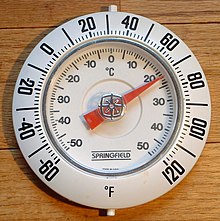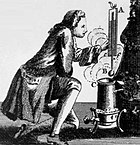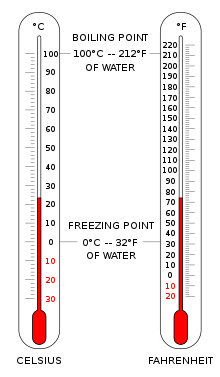Fahrenheit

Fahrenheit (symbol °F) is a temperature scale based on one proposed in 1724 by the German physicist Daniel Gabriel Fahrenheit (1686–1736), after whom the scale is named.[1] On Fahrenheit's original scale the lower defining point was the lowest temperature to which he could reproducibly cool brine (defining 0 degrees), while the highest was that of the average human core body temperature (defining 100 degrees). There exist several stories on the exact original definition of his scale; however, some of the specifics have been presumed lost or exaggerated with time. The scale is now usually defined by two fixed points: the temperature at which water freezes into ice is defined as 32 degrees, and the boiling point of water is defined to be 212 degrees, a 180-degree separation, as defined at sea level and standard atmospheric pressure.
By the end of the 20th century, most countries used the Celsius scale, rather than the Fahrenheit scale, as the Celsius scale is more simplistic with water freezing at 0° and boiling at 100°. Fahrenheit remains the official scale for the following countries and territories: the Bahamas,[2] Belize,[3] the Cayman Islands,[4] Palau,[citation needed] and the United States and its associated territories of American Samoa and the U.S. Virgin Islands (except Puerto Rico and Guam, with the former predominantely using Celsius and the latter equally using Celsius and Fahrenheit). Canada retains it as a supplementary scale that can be used alongside Celsius.[5][6][7][8]
The Rankine temperature scale was based upon the Fahrenheit temperature scale, with its zero representing absolute zero instead.
Definition and conversions
| from Fahrenheit | to Fahrenheit | |
|---|---|---|
| Celsius | x °F ≘ (x − 32) × 5/9 °C | x °C ≘ (x × 9/5 + 32) °F |
| Kelvin | x °F ≘ (x + 459.67) × 5/9 K | x K ≘ (x × 9/5 − 459.67) °F |
| Rankine | x °F ≘ (x + 459.67) °R | x °R ≘ (x − 459.67) °F |
| For temperature intervals rather than specific temperatures, 1 °F = 1 °R = 5/9 °C = 5/9 K Conversion between temperature scales | ||
On the Fahrenheit scale, the freezing point of water is 32 degrees Fahrenheit (°F) and the boiling point is 212 °F (at standard atmospheric pressure). This puts the boiling and freezing points of water exactly 180 degrees apart.[9] Therefore, a degree on the Fahrenheit scale is 1⁄180 of the interval between the freezing point and the boiling point. On the Celsius scale, the freezing and boiling points of water are 100 degrees apart. A temperature interval of 1 °F is equal to an interval of 5⁄9 degrees Celsius. The Fahrenheit and Celsius scales intersect at −40° (−40 °F and −40 °C represent the same temperature).
Absolute zero is −273.15 °C or −459.67 °F. The Rankine temperature scale uses degree intervals of the same size as those of the Fahrenheit scale, except that absolute zero is 0 R – the same way that the Kelvin temperature scale matches the Celsius scale, except that absolute zero is 0 K.[9]
The Fahrenheit scale uses the symbol ° to denote a point on the temperature scale (as does Celsius) and the letter F to indicate the use of the Fahrenheit scale (e.g. "Gallium melts at 85.5763 °F"),[10] as well as to denote a difference between temperatures or an uncertainty in temperature (e.g. "The output of the heat exchanger experiences an increase of 72 °F" and "Our standard uncertainty is ±5 °F").
A rough conversion between degrees Celsius and degrees Fahrenheit is as follows:[11]
- Fahrenheit to Celsius: Subtract 32 and halve the resulting number.
- Celsius to Fahrenheit: Double the number and add 32.
This formula gives an answer correct to within 1 °C for 0 °F (−17.8 °C) and within 4 °C for 100 °F (37.8 °C). For an accurate conversion, the following formulas can be applied:
Fahrenheit to Celsius : (°F − 32) ÷ 1.8 =°C
Celsius to Fahrenheit : (°C × 1.8) + 32 =°F
History

Fahrenheit proposed his temperature scale in 1724, basing it on three reference points of temperature.[9] In his initial scale (which is not the final Fahrenheit scale), the zero point is determined by placing the thermometer in brine: he used a mixture of ice, water, and ammonium chloride, a salt, at a 1:1:1 ratio. This is a frigorific mixture which stabilizes its temperature automatically: that stable temperature was defined as 0 °F (−17.78 °C). The second point, at 32 degrees, was a mixture of ice and water without the ammonium chloride at a 1:1 ratio. The third point, 96 degrees, was approximately the human body temperature, then called "blood-heat".[12]
According to a story and trivia question in Germany, Fahrenheit actually chose the lowest air temperature measured in his hometown Gdańsk in winter 1708/09 as 0 °F, and only later had the need to be able to make this value reproducible using brine.[13] This is one explanation given why 0 °F is −17.78 °C, but the ammonium chloride cooling temperature actually is −3 °C, whereas that of NaCl is −21.1 °C; the other explanation is that he did not have a good enough brine solution to obtain the eutectic equilibrium exactly (i.e. he might have had a mixture of salts, or it had not fully dissolved). In any case, the definition of the Fahrenheit scale has changed since.
According to a letter Fahrenheit wrote to his friend Herman Boerhaave,[14] his scale was built on the work of Ole Rømer, whom he had met earlier. In Rømer's scale, brine freezes at zero, water freezes and melts at 7.5 degrees, body temperature is 22.5, and water boils at 60 degrees. Fahrenheit multiplied each value by four in order to eliminate fractions and increase the granularity of the scale. He then re-calibrated his scale using the melting point of ice and normal human body temperature (which were at 30 and 90 degrees); he adjusted the scale so that the melting point of ice would be 32 degrees and body temperature 96 degrees, so that 64 intervals would separate the two, allowing him to mark degree lines on his instruments by simply bisecting the interval six times (since 64 is 2 to the sixth power).[12][15]
Fahrenheit observed that water boils at about 212 degrees using this scale. Later, other scientists[who?] decided to redefine the scale slightly to make the freezing point exactly 32 °F, and the boiling point exactly 212 °F or 180 degrees higher.[citation needed] It is for this reason that normal human body temperature is approximately 98° (oral temperature) on the revised scale (whereas it was 90° on Fahrenheit's multiplication of Rømer, and 96° on his original scale).[16]
Usage

The Fahrenheit scale was the primary temperature standard for climatic, industrial and medical purposes in English-speaking countries until the 1960s. In the late 1960s and 1970s, the Celsius scale replaced Fahrenheit in almost all of those countries — with the notable exception of the United States — typically during their metrication process.
Fahrenheit is used in the Bahamas, Belize, the Cayman Islands, Palau, and the United States and associated territories of American Samoa and the U.S. Virgin Islands for everyday applications (although Puerto Rico and Guam, use Celsius alongside Fahrenheit as well). For example, U.S. weather forecasts, food cooking, and freezing temperatures are typically given in degrees Fahrenheit. Scientists, such as meteorologists, use Celsius or Kelvin in all countries.[17]
Early in the twentieth century, Halsey and Dale suggested that the resistance to the use of centigrade (now Celsius) system in the U.S. included the larger size of each degree Celsius and the lower zero point in the Fahrenheit system.[18]
Canada has passed legislation favoring the International System of Units, while also maintaining legal definitions for traditional Canadian imperial units.[19] Canadian weather reports are conveyed using degrees Celsius with occasional reference to Fahrenheit especially for cross-border broadcasts. Virtually all Canadian ovens make legal use of the Fahrenheit scale.[20] Thermometers, both digital and analog, sold in Canada usually employ both the Celsius and Fahrenheit scales.[21][22][23] Also, in some instances (swimming pool temperature or cooking temperatures in Québec for example), temperatures are still expressed in Fahrenheit.

Within the European Union, it is mandatory to use kelvins or degrees Celsius when quoting temperature for "economic, public health, public safety and administrative" purposes, though degrees Fahrenheit may be used alongside degrees Celsius as a supplementary unit.[24] For example, the laundry symbols used in the United Kingdom follow the recommendations of ISO 3758:2005 showing the temperature of the washing machine water in degrees Celsius only.[25] The equivalent label in North America uses one to six dots to denote temperature with an optional temperature in degrees Celsius.[26][27]
Within the unregulated sector, such as journalism, the use of Fahrenheit in the United Kingdom follows no fixed pattern with degrees Fahrenheit often appearing alongside degrees Celsius. The Daily Mail, on its daily weather page, quotes Celsius first, followed by Fahrenheit in brackets,[28] The Daily Telegraph does not mention Fahrenheit on its daily weather page[29] while The Times also has an all-metric daily weather page but has a Celsius-to-Fahrenheit conversion table.[30] When publishing news stories, much of the UK press adopted a convention of using degrees Celsius in headlines relating to low temperatures and Fahrenheit for high temperatures. In February 2006, the writer of an article in The Times suggested that the rationale was one of emphasis: "−6 °C" sounds colder than "21 °F" and "94 °F" sounds more impressive than "34 °C".[31]
Unicode representation of symbol
The Fahrenheit symbol has its own Unicode character: "℉"(U+2109). This is a compatibility character encoded for roundtrip compatibility with legacy CJK encodings (which included it to conform to layout in square ideographic character cells) and vertical layout. Use of compatibility characters is discouraged by the Unicode Consortium. The ordinary degree sign (U+00B0) followed by the Latin letter F ("°F") is thus the preferred way of recording the symbol for degree Fahrenheit.[32]
See also
Notes and references
- ^ Robert T. Balmer (2010). Modern Engineering Thermodynamics. Academic Press. p. 9. ISBN 978-0-12-374996-3. Retrieved 2011-07-17.
- ^ The Official Site of the Bahamas. "Weather". Retrieved 2014-01-17.
- ^ Belize National Meterotrological Service. "Hydromet". Retrieved 2014-01-17.
- ^ Cayman Islands National Weather Service. "National Weather Service". Retrieved 2014-01-17.
- ^ Weights and Measures Act, accessed February 2012, Act current to 2012-01-18. Canadian units (5) The Canadian units of measurement are as set out and defined in Schedule II, and the symbols and abbreviations therefore are as added pursuant to subparagraph 6(1)(b)(ii).
- ^ Weights and Measures Act
- ^ Transportation Safety Board of Canada, accessed February 2012, Rail Report - 1996 - R96C0135. Section 1.0 (1.7 Particulars of the Track) The CWR was laid at a rail temperature of 85 degrees Fahrenheit (F). The desired laying temperature for this region is 85 °F. The rail temperature at Mile 119.8 shortly after the derailment location was noted to be 105 °F.
- ^ Environment Canada, accessed February 2012. Environment Canada (Canada's government sanctioned weather bureau), unlike Britain's Met Office and Australia's Bureau of Meteorology etc, offers an imperial option alongside the metric. This is in full compliance with Canadian law and would not otherwise be available if the Fahrenheit scale (and indeed all other imperial measurements) did not have legal recognition in Canada.
- ^ a b c Walt Boyes (2009). Instrumentation Reference Book. Butterworth-Heinemann. pp. 273–274. ISBN 978-0-7506-8308-1. Retrieved 2011-07-17.
- ^ Preston–Thomas, H. (1990). "The International Temperature Scale of 1990 (ITS-90)" (PDF). Metrologia. 27: 6. Bibcode:1990Metro..27....3P. doi:10.1088/0026-1394/27/1/002. Retrieved 2011-07-17.
- ^ Zaslavsky, Claudia (1999). Fear of Math: How to Get Over It and Get on With Your Life. Rutgers University Press (published 1994). p. 145. ISBN 0-8135-2099-1.
- ^ a b Frautschi, Steven C.; Richard P. Olenick; Tom M. Apostol; David L. Goodstein (2008-01-14). The mechanical universe: mechanics and heat. Cambridge University Press. p. 502. ISBN 978-0-521-71590-4.
- ^ "Wetterlexikon - Lufttemperatur" (in German). Deutscher Wetterdienst. Retrieved 13 December 2013.
- ^ Ernst Cohen and W.A.T. Cohen-De Meester. Chemisch Weekblad, volume 33 (1936), pages 374–393, cited and translated in http://www.sizes.com:80/units/temperature_Fahrenheit.htm
- ^ Cecil Adams. "On the Fahrenheit scale, do 0 and 100 have any special significance?". The Straight Dope.
- ^ Elert, Glenn; Forsberg, C; Wahren, LK (2002). "Temperature of a Healthy Human (Body Temperature)". Scandinavian Journal of Caring Sciences. 16 (2): 122–8. doi:10.1046/j.1471-6712.2002.00069.x. PMID 12000664. Retrieved 2008.
{{cite journal}}: Check date values in:|accessdate=(help) - ^ "782 - Aerodrome reports and forecasts: A user's handbook to the codes". World Meteorological Organization. Retrieved 2009-09-23.
- ^ Halsey, Frederick A., Dale, Samuel S. (1919). The metric fallacy (2 ed.). The American Institute of Weights and Measures. pp. 165–166, 176–177. Retrieved 2009-05-19.
{{cite book}}: CS1 maint: multiple names: authors list (link) - ^ "Canadian Units of Measurement; Department of Justice, Weights and Measures Act (R.S.C., 1985, c. W-6)". Current to 2011-05-17. Retrieved June 5, 2011.
{{cite web}}: Check date values in:|date=(help) - ^ Pearlstein, Steven (2000-06-04). "Did Canada go metric? Yes - and no". The Seattle Times. Retrieved June 5, 2011.
- ^ "Example of analog thermometer frequently used in Canada". Retrieved June 6, 2011.
- ^ "Example of digital thermometer frequently used in Canada". Retrieved June 6, 2011.
- ^ Department of Justice (2009-02-26). "Canadian Weights and Measures Act". Federal Government of Canada. Retrieved 2011-07-17.
- ^ Statutory Instrument 2009/3046 - Weights and Measures - The Units of Measurement Regulations 2009 (PDF),
"The Secretary of State, being a Minister designated(a) for the purposes of section 2(2) of the European Communities Act 1972(b) in relation to units of measurement to be used for economic, health, safety, or administrative purposes, in exercise of the powers conferred by that subsection, makes the following Regulations:
- ^ "Home Laundering Consultative Council - What Symbols Mean". Home Laundering Consultative Council. Retrieved 15 July 2013.
- ^ "Guide to Common Home Laundering & Drycleaning Symbols". Textile Industry Affairs. 2010. Retrieved 15 July 2013.
- ^ "Guide to Apparel and Textile Care Symbols". Office of Consumer Affairs, Government of Canada. Retrieved 15 July 2013.
- ^ "Weather". The Daily Mail. 3 July 2013. p. 3.
- ^ "Weather". The Daily Telegraph. 3 July 2013. p. 31.
- ^ "Weather". The Times. 3 July 2013. p. 55.
- ^ "Measure for measure". The Times. Times Newspapers. 23 February 2006.
- ^ The Unicode Standard, Version 6.2 (PDF). Mountain View, CA, USA: The Unicode Consortium. September 2012. p. 497. ISBN 978-1-936213-07-8. Retrieved 25 September 2014.
